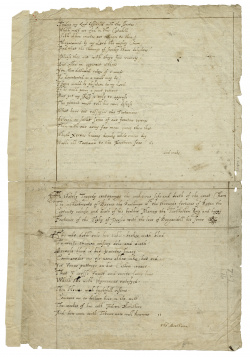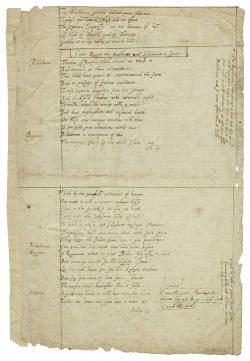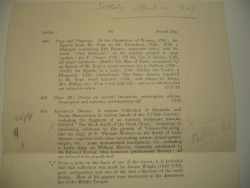Stately Tragedy of the Great Cham (Folger MS. X.d.259)
NB. This play is not to be confused with the two part Tamar Cham plays in the repertory of the Strange's men (1592-3) and Admiral's men (1596).
Alternative titles:
- “She who doth rule her table books with blood” (from the Prologue)
- “Life and death of the great Cham”
- “The Great Cham”
- “A stately tragedy containing the ambitious life and death of the great Cham”
Historical Records
Folger Shakespeare Library MS fragment
This play exists only as a two-leaf MS fragment (4 pages) (MS. X.d.259, formerly Folger MS 450528):

|

|
| Folger X.d.259, verso. (CC BY-SA 4.0 licence; click image to view larger version). |
Folger X.d.259, recto. (CC BY-SA 4.0 licence; click image to view larger version). |
Transcription
[p4]
Finding my Lord displeased with the sportes /
Which most are vsed in this Cytadell /
Sith other courtes are cottages to this /
Mayntained by my Lord the mighty Cham /
And that the change of sundry choice delightes /
Please thee not with theyr fine variety /
But often in apparent actions
You shew disturbed tokens of a minde
As discontented as a mynde may be /
I fayne would be phisition to my Lord
If he would proue a quiet patient
But yet my skill is only to appease
The patient must tell his owne desease
What haue our vassayles the Tartarians
Beseegd or sackt some of our fronter townes
Then with our army far more great then that /
Which Xerxes hauing dronke whole riuers dry
Waste all Tartaria to the Northren seas / 61
- and
- and
[p1]
A stately Tragedy contayninge the ambitious life and death of the great Cham
The inchantments of Bagous the Brachman wth the straunge fortunes of Roxen the
Captiuity release and death of his brother Manzor the Turchestan king and happy
Fortunes of the Sophy of Persia with the loue of Bargandell his sonne *
She who doth rule hir table-bookes with blud
To write thereon misery dole and death
Because blud is hir patrons liuery .
Commaundes me vse none other inke but red .
Yet Venus puttinge on hir Ceston craues .
That I crosse Incest and recite same loue
Which she with Hymeneus ratefyed .
Then Hecate with frightfull visions .
Coniures me to declare heer in the west /
The workes of her east Indian Ministers
And how euen with Tobacco now well knowne 11
- the Brachman /
- the Brachman /
[p2]
| The Brachman priests delude poore Indians . | |||
| To please the Tragick Muse and not offend | |||
| The Paphian Empresse , nor the Queene of hell / | |||
| Of blud of Magick and of Mariage / | |||
| Gentles it is my taske at once to tell . | |||
| __________________________________ | |||
| Enter Bagous the Brachman and Aldeboran a spirit . | |||
| __________________________________ | |||
| Aldeboran | Fiendes of Auernus shall attend on thee / + | ||
| And tremble at thine incantations / | |||
| Thou shalt haue power to countermaund the fates | |||
| And to presage of future accidents | |||
| To rise Latonas daughter from her spheare / | |||
| And blindfold Phœbus with æternall night | 10 | ||
| To walke about the worlde with a wish. | |||
| And dart destruction and deserued death . | |||
| On those who manage enmities with thee | |||
| If you plot your ententions with mee . | |||
| Bagous. | Aldeboran in recompence of this | ||
| The mouinge spirit by the which I liue 28 | |||
| wch by |
[In the right margin is a note, written sideways, corresponding to the mark in line 7:
+ The Brachman commeth out alone but the deuell
must rise from vnder the stage in a flash of
fier and he must returne in at the dore with
Brachman and so euer after till at last .]
[p3]
| Which by the powrfull architent of heauen | |||
| Was made to rest in neuer – endinge blisse | |||
| * | Euen in the Paradise at Ga[n]ges head | ||
| I giue vnto the loathsome lakes of hell / | |||
| To bath in those hot sulphure – boylinge streames / | |||
| Compassing hell nine times that with such fence / | |||
| Aldeboran . | You giue me but what was mine owne before . | ||
| Bagous . | I know not what to giue. Ald: Ile ask no more | ||
| But comminge now to see the mighty Cham / | |||
| Let him not know you for the Sophyes brother | |||
| But say you came of late from Calecut | |||
| The reason shall hereafter shew it selfe . | [Exunt] | ||
| Drepona | Depart and leaue vs with our thoughts alone | [Enter the great Cham named / Velraus his wife Drepona and Garde] | |
| Answer the suters weel giue eare to none 43 | [Exunt the Gard] | ||
| finding my |
[In the right margin, written sideways is a note corresponding to the asterisk in line 3:
* and he hath a crowne borne before
him and a dukes hatt which are set downe
one a little table]
Theatrical Provenance
Unknown. Former owners of the MS include:
- Sir Israel Gollancz, 1864-1930
- James Wright, 1643-1713 (possibly)
Probable Genre(s)
“Unusual burlesque masque” (Sotheby brochure, 12 April 1927); Tragedy (Harbage); eastern; conqueror play.
Possible Narrative and Dramatic Sources and Analogues
Subject matter
McInnis (73-74):
- In addition to the Great Cham’s history, the fragment’s title reveals that the lost play concerned itself with the 'inchantments of Bagous the Brachman[,] wth the straunge fortunes of Roxen[;] the Captiuity[,] release and death of his brother Manzor the Turchestan King[;] and [the] happy Fortunes of the Sophy of Persia[,] with the loue of Bargandell his sonne.' Here again are the makings of a typical eastern play: a captivity narrative, a Persian Sophy and Turkestan King, and an all-powerful Cham, Velruus, whose wife Drepona declares 'other courtes are cottages to this / Mayntained by my Lord the mighty Cham' (Anon., 'A stately tragedy' 45-6). In her speculation that her husband’s displeasure stems from 'our vassayles the Tartarians' having 'Bessegd or sackt some of our fronter townes' (57-8), Drepona effectively hints at the possibility that the Cham of the lost play had even greater analogy with the all-conquering Tamburlaine of Marlowe’s creation; Drepona’s hyperbolical (and typically Marlovian) solution to the dilemma is for 'our army far more great' to 'Waste all Tartaria to the Northren Seas' (59, 61).
- But whereas the title of this lost play would suggest an imitation of Tamburlaine on par with the 'weak sons' and, to a lesser extent, of 'Tamar Cham', an engagement with Faustian magic is evident even from the fragment’s two extant pages. When Bagous the Brachman (an eastern priest figure; possibly a eunuch -- see Elyot, Bibliotheca Eliotae f.i) enters the stage alone, he is joined by Aldeboran, a spirit or “deuill” who the stage direction explains “must rise from vnder the stage in a flash of fier” (17 SD). Aldeboran wastes no time establishing a Faustian pact with Bagous, offering him diabolical temptations:
- Fiendes of Auernus shall attend on thee
- And tremble at thine incantations
- Thou shalt haue power to countermand the fates
- And to presage of future accidents
- To rise Latonas daughter from her spheare
- And blindfold Phœbus with æternall might
- To walke about the worlde with a wish
- And dart destruction and deserued death
- On those who manage enmities with thee
- If you plot your ententions with mee. (17-26)
- Fiendes of Auernus shall attend on thee
Dramatis Personae
- Bagous the Brachman (brother of the Sophy?)
- Roxen
- Manzor, his brother and the Turchestan King
- The Sophy of Persia
- Bargandell, his son
- Aldeboran, a spirit
- Velruus (or Velraus), the Great Cham
- Drepona, his wife
- a guard
References to the Play
None known.
Critical Commentary
 Sotheby's auction catalogue, 12 April 1927 Courtesy of the Folger Shakespeare Library |
A facsimile of the manuscript was printed by The Malone Society in G. R. Proudfoot, “Five Dramatic Fragments,” Collections, Volume IX (Oxford: OUP, 1971 [1977]), pp.52-75. Pp.64-67 reproduces a transcript of the text.
Genre
According to the Folger’s catalogue, it was “[d]escribed in the Sotheby April 12 1927 brochure as ‘the fragment of an unusual burlesque masque, entitled ‘The life & death of the Great Cham,’ containing an interesting reference to the growth of Tobacco-Smoking’ (85).” Bentley disagreed with this classification: “The Great Cham is certainly not a masque. As for burlesque, the style is inflated and the tone of the prologue ambiguous, but there is not enough in these sixty-one lines to demonstrate that the attitude of the author was mocking rather than naively solemn” (V.1345).
Date
The c.1590 date comes from the Folger’s own catalogue. The Sotheby catalogue lists it as a Jacobean drama. Bentley notes that “the tobacco reference is the only reason for calling The Great Cham Jacobean, for it could be earlier or later than the time of James I” (V.1345). Wagonheim’s revision of Harbage merely lists the fragment as “17th Cent.” (Supp. List I.). Proudfoot, in his Malone Society edition of the fragment, allows that “[a]n earlier limit is suggested by the style and allusions, which imply knowledge of the tragic writing of the later 1580s and early 1590s” (64-65) but concludes that “a date within the first two decades of the [17th] century may seem likely enough” (65).
For What It's Worth
Bagous the Brachman, an eastern priest figure, is also possibly a eunuch: “Bagôus, in the Persian tunge signifieth a geldynge, or a man geldyd” (Elyot sig. f.i). Proudfoot, however, thinks “the name ‘Bagous’ recalls the ‘Bagoa’ of Lyly’s Endimion” (64-65).
The name Aldeboran, here a spirit or “deuill”, is also associated with a star.
cf. Tamburlaine: “Raise me to match the faire Aldebaran, / Above the threefold astracism of heaven” (2 Tam, 4.3.61-62)
cf. Agrippa: “The third is the star Aldeboran” (p64).
The name Velruus (or Velraus), for the Great Cham, may simply be related to / derived from the ostensibly authentic Tartarian word for “mighty king” (“Vlu-Chan”). In his discussion of “The ruine of the Turks first Empire in Persia: with the successe of their second kingdome in the lesser Asia vnder the Aladin Kings,” Knolles writes:
the Tartars or rather Tattars . . . stirred vp by their owne wants, and the persuasion of one Zingis (or as some call him, Cangis) holden amongst them for a great prophet, and now by them made their leader, and honoured with the name of Vlu-Chan, that is to say, the Mightie king (commonly called the great Cham)…. (75)
An EEBO-TCP search indicates that the name "Bargandel" occurs uniquely in The Mirror of Knighthood (English trans. 1583 and 1599 by "R.P." --- Robert Parry or Robert Parke?), where it belongs to a Bohemian prince who wanders through the kingdom of Lusitania accompanied by two other princes, Lyriamandro and a Tartarian called Zoylo.
Works Cited
Site created by David McInnis, University of Melbourne; updated by Matthew Steggle, 04 Feb 2011; last updated 20 June 2016.